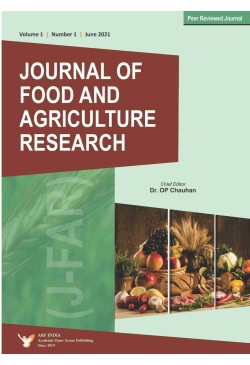
Journal of Food and Agriculture Research
Frequency :Bi-Annual
ISSN :2583-1291
Peer Reviewed Journal
Editorial
Optimization and Characterization of Cookies from Malted Foxtail Millet and Lentil Flour
J. Surya Teja, S. Thangalakshmi, Rakhi Singh, Anurag Singh, Barjinder Pal Kaur, Vivek K. Bajpai & Shivangi Mishra. 2022. Optimization and Characterization of Cookies from Malted Foxtail Millet and Lentil Flour. Journal of Food and Agriculture Research, 2: 2, pp. 77-93. https://doi.org/10.47509/JFAR.2022.v02i02.01
COVID-19 and Gastrointestinal Infection: New Approaches for Disease Management
Aditi Sharma & Deepali Singh. 2022. COVID-19 and Gastrointestinal Infection: New Approaches for Disease Management. Journal of Food and Agriculture Research, 2: 2, pp. 95-113. https://doi.org/10.47509/JFAR.2022.v02i02.02
Development of Osmotically Dehydrated Sweet Potato (Ipomoea batatas (L.) Lam.) Slices Incorporated with Pineapple Juice and Evaluation of its Chemical and Nutritional Properties
Dhruv Kumar Jain & OP Chauhan 2022. Development of Osmotically Dehydrated Sweet Potato (Ipomoea batatas (L.) Lam.) Slices Incorporated with Pineapple Juice and Evaluation of its Chemical and nutritional Properties. Journal of Food and Agriculture Research, 2: 2, pp. 115-128. https://doi.org/10.47509/JFAR.2022.v02i02.03
Response of Foliar Application of Calcium and Boron on Vegetative and Reproductive Traits of Jackfruit (Artocarpus heterophyllus L.)
Pratibha, Shikha, Rajesh Kumar, Ratna Rai & Ravi Kumar 2022. Response of Foliar Application of Calcium and Boron on Vegetable and Reproductive Traits of Jackfruit (Artocarpus heterophyllus L.). Journal of Food and Agriculture Research, 2: 2, pp. 129-137. https://doi.org/10.47509/JFAR.2022.v02i02.04
Exploring Endophytes of Ginger for Sustainable Plant Growth Promotion and Secondary Metabolite Production
Endophytes, residing within plant tissues, have garnered attention for their ability to enhance plant health and contribute to secondary metabolite synthesis. Ginger, a rhizomatous and aromatic plant with medicinal properties, is renowned for its volatile oils and bioactive compounds such as gingerol, paradol, and shogaols. Widely utilized in Ayurvedic and Chinese medicine, ginger has demonstrated efficacy in treating various ailments. The bioactivity and quality of ginger extracts are intricately linked to the presence of endophytic fungi and bacteria residing within the plant’s rhizomes. These endophytic microorganisms contribute significantly to the metabolite profile of ginger, producing compounds with diverse bioactivities, including antibacterial, antifungal, cytotoxic, anticancerous, antioxidant, and anti-inflammatory properties. The synthesis of these metabolites is often triggered by host-specific phytopathogens. Interestingly, many of these metabolites have been identified to possess characteristics that foster plant development. This review explores the potential of the endophytic community within ginger and delves into the role of their metabolites in enhancing plant growth, shedding light on the intricate interactions between plants and microbes. Understanding these dynamics not only enriches our knowledge of plant-microbe associations but also unveils the promising prospects of harnessing the endophytic potential for sustainable plant cultivation and medicinal applications.
Arpana Jayan, Priya George, Fathima Dilkushand & C. Sarathambal 2022. Exploring Endophytes of Ginger for Sustainable Plant Growth Promotion and Secondary Metabolite Production. Journal of Food and Agriculture Research, 2: 2, pp. 139-149. https://doi.org/10.47509/JFAR.2022.v02i02.05